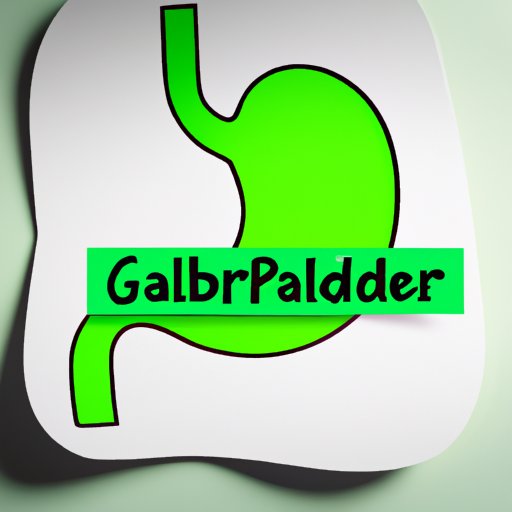
I. Introduction
Our gallbladder is an important organ that aids in the digestive process by storing and releasing bile, a fluid produced by the liver. Unfortunately, our gallbladder’s health is often taken for granted, and we may not realize the signs of a bad gallbladder until it is too late. Recognizing the symptoms of a bad gallbladder is crucial in order to prevent potential complications. This article aims to inform readers of the warning signs to look out for and how to maintain good gallbladder health.
II. A Beginner’s Guide to Understanding Gallbladder Health: How to Recognize Signs of a Bad Gallbladder
Before recognizing the warning signs of a bad gallbladder, it is important to understand what the gallbladder is and its function in the digestive system. The gallbladder is a small, pear-shaped organ located in the upper right side of the abdomen. Its main function is to store and release bile, which helps break down fats during the digestive process.
Potential problems with the gallbladder can be caused by several factors, including gallstones, inflammation, or infection. These issues can cause pain, discomfort, and other unpleasant symptoms.
The most common symptoms associated with a bad gallbladder include:
- Abdominal pain or tenderness on the right side
- Nausea or vomiting
- Fever or chills
- Bloating or indigestion after meals
- Jaundice (yellowing of the skin or eyes)
III. 5 Warning Signs That Your Gallbladder May Be in Trouble and What to Do About It
Recognizing the warning signs of a bad gallbladder is crucial in order to prevent potential complications. Here are 5 of the most common warning signs of gallbladder-related problems that you should look out for:
- Sharp, sudden pain in the upper right side of the abdomen: This pain may radiate to the back or right shoulder blade and can last from 15 minutes to several hours.
- Indigestion or bloating after meals: This is caused by the gallbladder not releasing enough bile to digest fats, leading to indigestion and bloating.
- Nausea or vomiting: The buildup of bile in the gallbladder can cause nausea or vomiting, especially after eating fatty foods.
- Clay-colored stools: This is caused by a lack of bile in the stool, which can indicate a blockage in the bile duct.
- Jaundice: This is caused by a buildup of bilirubin in the blood, leading to yellowing of the skin or eyes.
If you notice any of these warning signs, it is important to seek medical attention. In some cases, surgery may be required to remove the gallbladder.
IV. What Your Doctor Won’t Tell You About Your Gallbladder: How to Spot Red Flags and Seek Treatment
While the symptoms discussed in the previous section are common, there are also some red flag symptoms of a bad gallbladder that you need to be aware of. These symptoms may indicate a more serious problem and require immediate medical attention:
- Severe, sudden pain in the upper right side of the abdomen that lasts for several hours
- Fever or chills accompany abdominal pain and tenderness
- Sweating and clammy skin
- Rapid heartbeat or palpitations
- Difficulty breathing
If you are experiencing any of these symptoms, seek immediate medical attention. Your doctor may recommend tests to diagnose the problem, such as an ultrasound or CT scan. Treatment options may include medication, lifestyle changes, or surgery.
You can also take steps to prevent gallbladder-related problems by maintaining a healthy lifestyle. This includes eating a balanced diet, staying hydrated, and exercising regularly.
V. The Science Behind Gallbladder Pain: Common Symptoms and Root Causes
Gallbladder pain can be caused by several factors, including gallstones, inflammation, or infection. While the symptoms can vary, the most common symptoms associated with gallbladder pain include:
- Abdominal pain or tenderness on the right side
- Nausea or vomiting
- Fever or chills
- Bloating or indigestion after meals
- Jaundice (yellowing of the skin or eyes)
The root causes of gallbladder pain are often overlooked, but they can include factors such as genetics, diet, and lifestyle habits. For example, a diet high in saturated fats and cholesterol can increase your risk of developing gallstones, which can lead to pain and discomfort.
VI. Simple Lifestyle Changes That Can Improve Your Overall Gallbladder Health and Prevent Potential Issues
While there is no surefire way to prevent gallbladder-related problems, there are several lifestyle changes you can make to improve your overall gallbladder health:
- Eat a balanced diet that includes plenty of fruits, vegetables, and fiber
- Drink plenty of water and avoid sugary drinks
- Avoid foods high in saturated fats and cholesterol
- Exercise regularly
- Maintain a healthy weight
By making these lifestyle changes, you can reduce your risk of developing gallbladder-related problems and maintain good overall health.
VII. Conclusion
Recognizing the warning signs of a bad gallbladder is crucial in order to prevent potential complications. Symptoms of a bad gallbladder can include pain, nausea, fever, and jaundice, among other things. It is important to seek medical attention if you notice any of these symptoms or red flag symptoms such as severe pain, sweating, or difficulty breathing. Maintaining a healthy lifestyle, including a balanced diet and regular exercise, can help prevent potential issues and promote good overall gallbladder health.




